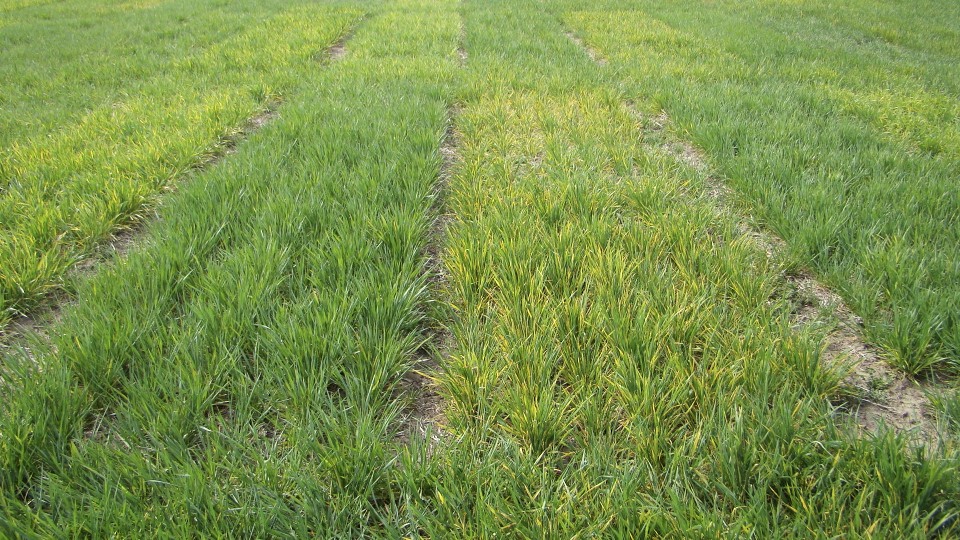
Agricultural News
Wheat Streak Mosaic a Major Worry for 2017 Oklahoma Wheat Crop- Dr. Bob Hunger
Sat, 06 May 2017 12:35:34 CDT
 Oklahoma State University Extension Pathologist Dr. Bob Hunger offers his latest wheat disease report as the 2017 wheat crop rapidly works its way toward harvest.
Oklahoma State University Extension Pathologist Dr. Bob Hunger offers his latest wheat disease report as the 2017 wheat crop rapidly works its way toward harvest.
"Nearly all of the wheat I saw this past week was along a line for about 100 miles west of Stillwater. Wheat around Stillwater is at the milk to soft dough stage. Wheat west of Stillwater ranged from full kernel to full kernel-milk. In this area, I saw both good and bad wheat. Much of the bad wheat I saw had been hit with wheat streak mosaic (WSM). To date, the Plant Disease and Insect Diagnostic Lab (Ms. Jen Olson, Director) has assessed about 82 wheat samples from 19 counties for Wheat streak mosaic virus (WSMV), High plains virus (HPV), and Barley yellow dwarf virus (BYDV; PAV strain). These 19 counties are located west of Stillwater, and mostly are west of I-35. Of these 82 samples, 56 were positive for WSMV, 11 were positive for HPV (all 11 co-infected with WSMV), and 42 were positive for BYDV. Four of the samples were positive for all three viruses. These figures indicate the severity of wheat viruses in Oklahoma this year. Reports from other states indicate this problem (mite transmitted viruses such as WSM) is just as severe up through the central plains. The cool, wet weather we have had can mitigate the effects of WSM and BYD, and help infected plants to continue to mature and finish. This would be especially true for plants/fields that were infected in the spring. However, yield and test weight will be affected especially if wheat was infected in the fall. For more information on mite-transmitted wheat viruses such as WSM, please see OSU Fact Sheet EPP-7328 (Wheat Streak Mosaic, High Plains Disease, and Triticum Mosaic: Three Virus Diseases of Wheat in Oklahoma) available by clicking or tapping here.
"Regarding leaf and stripe rust, I have seen mostly leaf rust over the last week, but signs of stripe rust (both active and inactive) also can be observed. On susceptible varieties that were not sprayed, leaf rust was severe (?60% flag leaf area showing pustules). In his nurseries at Lahoma in north-central OK, Dr. Brett Carver (OSU Wheat Breeder) is seeing some active and inactive stripe rust. Given our cool and wet weather, stripe rust appears to be re-activating. Dr. Carver also is seeing abundant and severe leaf rust.
Related to the rusts and fungicides, I came across an interesting situation in central OK that I would like to share. A producer called this past week indicating he had a wheat field with severe leaf rust on lower leaves but flag leaves were still green and rust free. So, he had the field sprayed with a triazole fungicide combination. About two weeks after spraying, he felt the flag leaves were showing rust and more flecking/chlorosis than should occur after a fungicide spray. A field visit confirmed what I had seen several years ago in my fungicide trial here at Stillwater in 2012, that is, fungicide was applied when flag leaves were infected with leaf rust but no pustules had yet been formed. With closer inspection I realized the "pustules" I was seeing were basically dead or dying and no viable spores were being formed. I vistied the field in question on Thursday, which was sprayed with a combination of triazole fungicides approximately two weeks earlier."
Upon examination, Dr. Hunger says that he saw in this field a couple of things to learn from. The first is that this is an example of the "curative" action of triazole fungicides. The leaves were infected with the leaf rust fungus and the fungus had grown through the flag leaf although no pustules had yet formed. Hence, the flag leaves were green and healthy appearing. Application of the fungicide killed the fungus over a period of time (i.e., "cured" the fungus). Even though "remnant" pustules formed, no viable spores formed in the pustules because the fungus was dead/dying. The second point (and perhaps most important point) is that this demonstrates the importance to apply a fungicide sooner rather than later. The application helped maintain some green leaf tissue, but if not applied when the fungicide was applied, these leaves would have been completely rusted and there would be no green flag leaf area left to contribute to grain fill. As it is, the wheat will see some yield and test weight reduction, but not nearly as much as if fungicide had not been applied.
WebReadyTM Powered by WireReady® NSI
Top Agricultural News
More Headlines...





